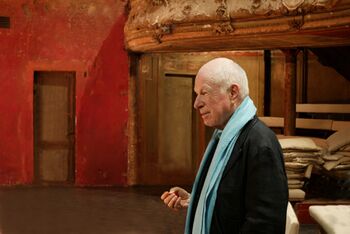The Empty Space
Peter Brook’s 1968 book, The Empty Space, describes four forms of theatre: deadly, holy, rough and immediate. These ideas have been foundational to how directors, actors, designers and others have thought about theatre in the late 20th century.
I can take any empty space and call it a bare stage. A man walks across this empty space whilst someone else is watching him, and this is all that is needed for an act of theatre to be engaged.
With this phrase the stage director Peter Brook (Q373) begins his book The Empty Space (Q374), synthesising in just two lines his idea of theatre. Brook looks for the essential and pushes aside all non-elementary components such as gestures, decoration or movement. Brook was born in London in 1925; after staging many productions, operas and films, he published his first book in 1968. The Empty Space marked the artistic desire of its author to abandon conventional theatres and, therefore, the proscenium arch, and to begin a long period of investigation into the fundamental essence of the scenic space. In his project there was no place for the artificial or the false, only the pure essence of scenography, which he later staged at the Bouffes du Nord in Paris (Q13498).
The text of The Empty Space is structured in four parts: the deadly theatre, the holy theatre, the rough theatre and the immediate theatre.
In the first part, Brook analyses the deadly theatre, which is the theatre that not only fails to inspire or instruct, but hardly entertains, and that can be found in grand opera, in tragedy, in Brecht’s work and, above all, in the works of Shakespeare. He reflects on the actor as an instrument of the dramatic art and compares it with the instruments of other arts. He also reflects on the public, on the flexibility of current staging, on the contradiction between literary and theatrical, and on the density of silence. Deadly theatre is a theatre that loses the public since it is not capable of inspiring or teaching, nor of entertaining – it is an insufficient theatre for society.
In the second part, he enters into the holy theatre which he calls ‘theatre of the invisible made visible’; that is, he reflects on the stage as a place where the invisible can appear, in the same way that in music we recognise the abstract through the concrete. He considers the loss of the original rite in the current theatre, except in certain oriental theatres. ‘The truth is that we don’t know how to celebrate, since we don't know what to celebrate.’ (Q374, 68). He recounts his experiences with the theatrical group Teatro de la Crueldad, which was created in order to investigate the sacred theatre. ‘We can try to capture the invisible but we must not lose touch with common sense: if our language is too special, we will lose part of the viewer’s faith.’ (Q374, 90).
In the third part, dedicated to rough theatre, Brook recognises popular theatre, the popular theatre that saves entire eras. He reminds us that the long popular tradition, apart from partying with harmless and happy people, is also fierce satire and grotesque caricature. He places this theatre in opposition to the sacred theatre.
In the last, most personal part dedicated to the immediate theatre, Brook expresses himself by way of an autobiographical conclusion. The immediate, the moment in which the theatre affirms itself in the present, is when the theatre becomes real, and also disturbing. Its immediacy characterises it, a representation that is unrepeatable, even if it needs repetition. The theatre not as an art in itself, but a reflection of life, which for its representation needs the observation and formation of values.
In 1969 Brook and producer Micheline Rozan created the Centre International de Recherche Théâtrale (CIRT), a multinational company of actors, set designers and directors. The company toured widely in the early 1970s through Asia, Africa and the United States, playing in villages, at immigrant hostels and in refugee camps, sometimes for people who had never seen theatre before.
In 1974, Brook and Micheline Rozan made a home for CIRT at the abandoned theatre of Bouffes-du-Nord (Q7983), in Paris. The theatre responds with its proportions and state of conservation to an aesthetic that the group had been formulating in its travels and with his research. While the theatre has been renovated, many original features have been retained, not restored but with the patina and distress of age – a carefully curated space that is both theatre and scenography, in line with Brook’s ideas about theatre.
Developments in theatre practice, as in other fields, rely on the sharing of knowledge and experience. Peter Brook’s book, The Empty Space, and his practice as a director, have ensured his ideas have been highly influential.

